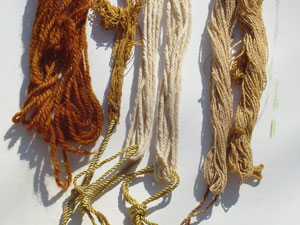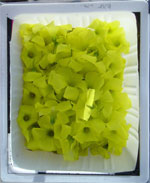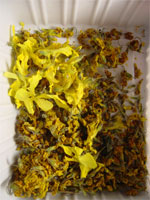 I tend to work with dried dye plant material rather than fresh. My gardening space is on the small side. Even with ‘weeds’ I rarely have enough fresh material so I’ve been concentrating on plants I can dry and save up over time.
I tend to work with dried dye plant material rather than fresh. My gardening space is on the small side. Even with ‘weeds’ I rarely have enough fresh material so I’ve been concentrating on plants I can dry and save up over time.
Red and blue aren’t a problem because I can purchase Madder and Indigo already dried. Onion peels (yellow to orange and rust) are dry and easy to store. Usually its the yellows that need some planning. Fennel is my local dryable yellow for wool and Oxalis for cotton (although it works on wool too). The dye books I’ve been reading tend to discuss the plant to dye stuff radio in terms of fresh dye material, often 1:1 (dye material:fiber) or in the case of cotton as much as 2:1 (dye material:fiber). The weight drops quite a bit in the drying so I did some before and after weighing to get a better idea of how much to use.
The dried Oxalis seems to be about 12% of the fresh. Which means 1:1, 2:1 or anything like that is way too much dye material.
 Fresh material weighed .9 oz or 25 g
Fresh material weighed .9 oz or 25 g
 Dried material weighed .1 oz or 3 gm.
Dried material weighed .1 oz or 3 gm.
For a long time I’ve used my trusty triple beam scale for measuring dye material. This had been given to me by my father. He always used a triple beam scale for measuring ceramic glaze chemicals and it was one of those things he thought I should know how to use correctly, along with tire changing and other useful stuff.
Recently I got my first digital scale. Obviously it must take very little to make me happy. I love the push-button tare function. (Way easier than zeroing out my old standard.) Also being able to switch between metric and that other thing by pushing a button. Even the cats like it.









